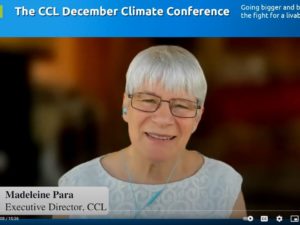By Tony Sirna, CCL Strategy Director
The recent “Net Zero by 2050” report from the International Energy Agency (IEA) was a clear wakeup call for policymakers and activists alike, saying, “The world has a viable pathway to building a global energy sector with net-zero emissions in 2050, but it is narrow and requires an unprecedented transformation of how energy is produced, transported and used globally.”
The report makes clear that the world needs to go beyond existing emissions reduction pledges and to begin implementing the policies that will drive emissions to net zero by 2050.
Their analysis hinges on “a complete transformation of how we produce, transport and consume energy,” with a massive deployment of renewable energy and an end to sales of internal combustion engines by 2035. Garnering the most attention was a call for “no investment in new fossil fuel supply projects” — a remarkable statement from an organization that was founded to focus on world oil supply and other traditional energy sources.
Carbon pricing: A key tool to reach net zero emissions by 2050
A crucial takeaway from the new report is that the IEA’s Net Zero Emissions Scenario relies heavily on carbon pricing as a key part of their policy recommendations. The International Energy Agency calls for carbon prices to be introduced in the immediate future in advanced economies like the U.S. that would rise to $130/ton by 2030 and $250/ton by 2050. Prices are assumed to be lower in emerging markets and developing economies, with all economies also implementing more direct policies to transform their energy systems (see table).
These price trajectories are similar to two of the carbon pricing bills currently in Congress that also call for net zero emissions by 2050. The Energy Innovation and Carbon Dividend Act (H.R.2307) would match the IEA’s suggested price in 2040 and exceed their price for 2050, but would be $20 and $25 lower for 2025 and 2030 respectively. The America’s Clean Future Fund Act (S.685) has a similar price trajectory but $10 lower for each year starting in 2023.
Carbon dividends for a people-centered transition
The IEA’s report also emphasizes that “Governments need to ensure that clean energy transitions are people-centered and inclusive…Ensuring the affordability of energy for households demands close attention: policy tools that can direct support to the poorest include tax credits, loans and targeted subsidies.” The International Energy Agency also supports revenue from a carbon price being used to “improve consumer welfare, particularly for low‐income households,” which is the key purpose of a carbon cash back or carbon dividend.
While the report was aimed primarily at policy makers, it also held a clear message for activists and the public, emphasizing the need for citizens to be engaged in the process, “A transition of the scale and speed described by the net zero pathway cannot be achieved without sustained support and participation from citizens.”
This report from the IEA adds another powerful voice calling for emissions to hit net zero by 2050 and using a price on carbon to get there. Let’s make sure Congress hears that call loud and clear.
TAKE ACTION NOW!







